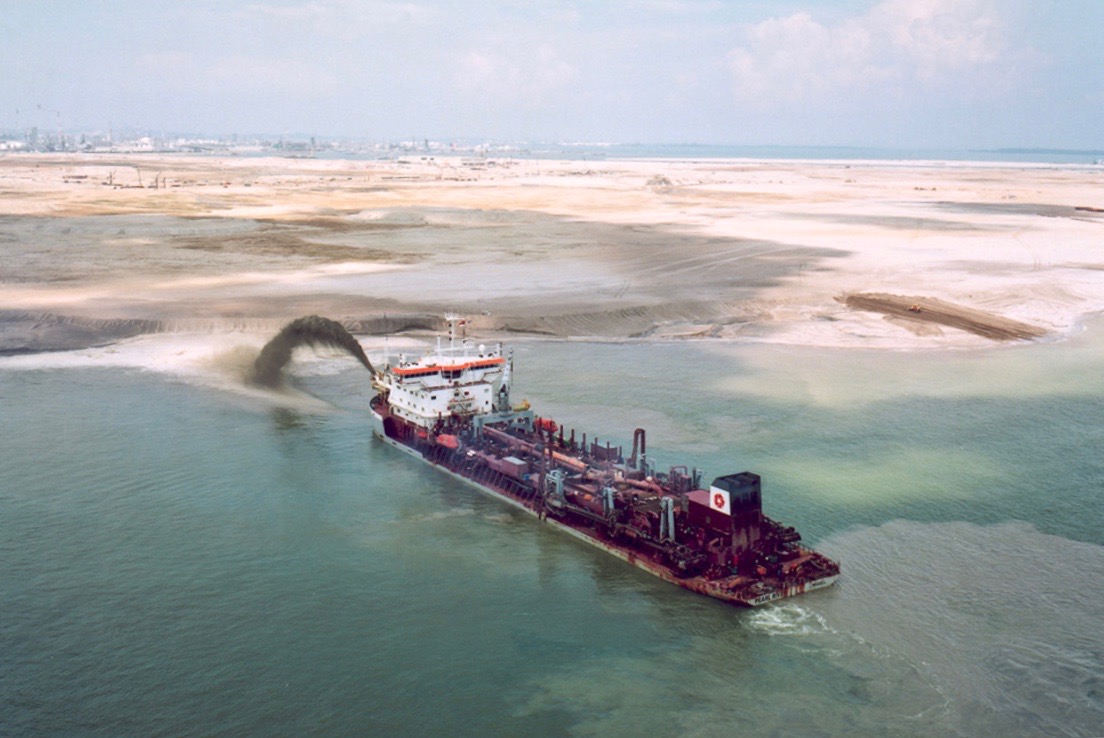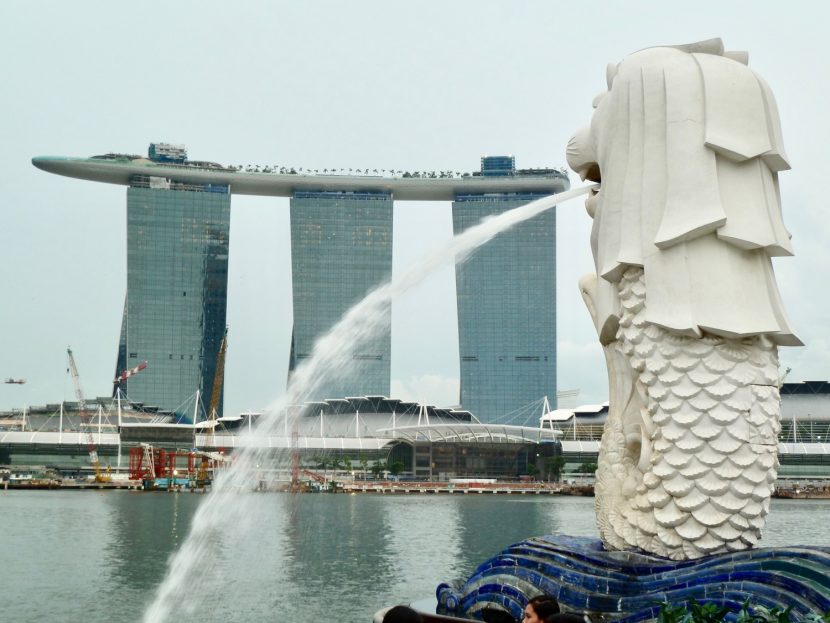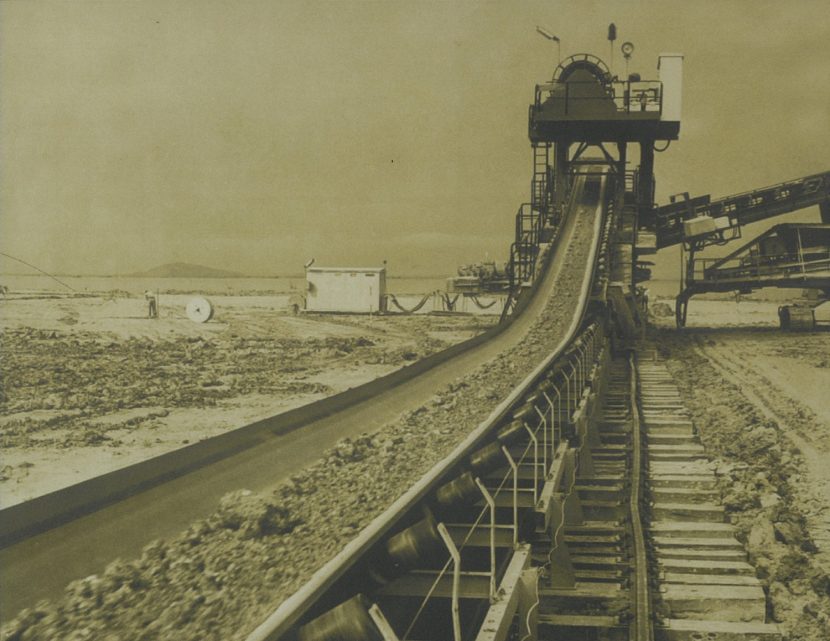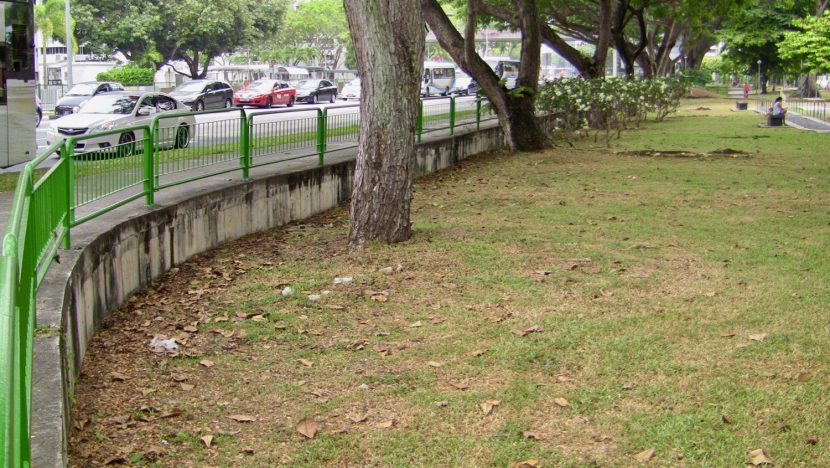Ten years ago, the Marina Bay Sands was a construction site of gaping excavations and rising dunes of dirt. Thirty years before that, it was not quite sea, not quite land: transitioning from the former to the latter. And before that simply unbuildable sea. Since its independence in 1965, Singapore has grown from around 590 km2 to 720km2 in 2014, reclaiming around 22% of its total ground area from the sea. Though correct in reference to the creation of land from where there was once ocean, reclamation is an odd word: it appears to imply that Singapore is retrieving something from the sea, re-claiming what was already its own, when it has in fact been building land where land had never existed before.
Singapore sees itself as chronically undersized: it imagines itself as a larger country, and works backwards: materialising the necessary geographical puzzle pieces to suit the demands of the global economy as much as to satiate its own needs. Space is not merely flexible, but hypothetical. Sites of reclamation are symbolic of and symbiotic with the State’s agenda of modernity which, as it shifts its focus from one productive phase of accumulation to another, construct temporal and economic inequalities through these new landscapes of power.
The reasons given for land reclamation are usually pragmatic; housing, ports, landfills, petrochemical plants – all kinds of infrastructure. The term even extends to the over-engineered starchitecture of the Marina Bay Sands Integrated Resort. Land reclamation has been Singapore’s key strategic infrastructure used to anticipate future trends in the global economy, constructing space for an upgraded port at Tuas, or reserving hectares around the Marina Bay site itself for future development of the Central Business District whilst Singapore grows as a finance centre.
With the Urban Redevelopment Authority projecting an additional 100km2 of land to be reclaimed by 2030, the question of what and who the space is for will only become more urgent. The State’s definition of ‘pragmatism’ fortifies this urgency, shifting with the increasingly delirious whims of the global economy. Enter the Marina Bay Sands, one of the most recent and most notorious realizations of the State’s ‘pragmatism’. The Integrated Resort of the Marina Bay Sands is free to access for tourists. For Singaporean citizens and permanent residents, you need to pay a $100 levy to gain entry for 24 hours, or $1000 for a one-year period.
In a national day speech in 2005, touching upon the presence of a casino on Singapore’s shores (which then seemed unlikely), Prime Minister Lee Hsien Loong stated that ‘we are not considering a casino, but an IR—an integrated resort’, and that ‘an IR is one significant idea we must consider, that will help us reinvent Singapore’. In one fell swoop, the cognitive dissonance of admitting the construction of casinos by rebranding them as ‘IRs’ was superseded by the overarching need to reinvent Singapore on the world stage and gain a competitive edge over other global cities like Sydney, New York, and London.
Though a far cry from the landmark monumentality of the Marina Bay Sands and Gardens by the Bay, a cursory look at the East Coast Reclamation scheme that began in 1965 reveals the tension inherent to this tool of national-building: the pragmatic rationalisation and realisation of space bears traces of the undesirable and discordant narratives it sought to suppress. The East Coast reclamation provided a public park and beachfront (where before there were private properties and swimming clubs, which the government then bought using laws of Compulsory Purchase), and extensive Housing Development Board (HDB) estates that would go on to form ‘New Towns’. Kampong dwellers (kampong: Malay for village) living in squalid conditions without plumbing or electricity and under constant threat of flooding and fire were gradually relocated to the initial HDB flats as they were built (though for each story of a fire spreading in a kampong, there exist apocryphal accounts of thugs hired by the government throwing burning torches onto attap roofs). The spectral threat of communists spreading dissent and slander in kampongs gave the government additional license to relocate their residents. Marine Parade was the first housing estate in the world to be built entirely on reclaimed land, and its initial phase was completed in 1973.
This relocation strategy worked, for the most part. Resettled kampong dwellers thought that the flats would fall back into the sea, saw cracks in the pavement as a sure sign of impending doom. What the resettlement was actually a sign of was the HDB’s success in rehousing a nation and the People’s Action Party’s successful consolidation of power. HDB flats can be bought using a Singaporean’s Central Provident Fund, the government’s mandatory savings programme, which helped put 90% of Singaporeans in HDB flats by the 1980s. However, what this has meant is that, as Singapore has ascended GDP per capita rankings and its property prices have skyrocketed, lower-income citizens have had to work for longer to pay off their mortgage.
As a nascent nation-state, the transition from one standard of living to an incomparably superior one was wrought through the government’s consolidation of its power to shape the literal and figurative horizons of its citizens, offering a new set of expectations between state and citizen.
One night, I was out by the Bedok Jetty on the East Coast; I met Fook Yang, a man in his sixties who grew up in a coastal kampong and was relocated to Marine Parade after the reclamation had been completed. His previous neighbourhood had been erased. When I approached him he had been waiting for a good catch for hours with old friends from the kampong, and told me that the fish here never recovered after the reclamation. He told me that at first, he thought it would only take ten years to pay off his flat; as Marine Parade became a more desirable area to live in, the property prices rose with the influx of more affluent Singaporeans and migrants, it had become clear it would take fifteen years to pay off his debt. Then twenty. Then thirty. The beach he grew up on no longer exists, where the land met the water is now the three-lane Marine Parade Road. Economic inequality is cloaked in the government’s spatial and temporal sleight of hand: no coastline to memorialize, no loss to mourn, no memory to pass on to the next generation. These details simply become features of Singapore’s successful economic model, with a majority of winners and a minority of losers (but with the terms of that success dictated by the State, of course).
You can walk around Bedok, a nearby area, and see road names like Telok Kurau, meaning ‘mango fish bay’, which gives memorial to the fact that five decades ago this is where people fished. Forensic clues are littered throughout Marine Parade, small traces of the original seam where it was stitched onto the original coastline, edges where the puzzle piece doesn’t quite fit: the original sea-level height of this public park cowers beneath the metre of built of cement where the road is, where the reclaimed land starts. If it does start there.
Marine Parade now is indistinguishable from any other old HDB estate in Singapore; it is quiet, a little grey, but equally serene, woozy with trees, a place where people live. Old residents of Marine Parade still remember this place as a series of desolate mud and sand flats, the conveyor belt of dirt that turned nearby hills into fill material for reclamation, flattening Bedok and Tanah Merah, the wind picking up and spreading dust over everything. Or the abundance of the fish along that coast, before the reclamation dredging stirred up enough silt to ward off any marine life, and the increasing number of tankers in the Strait ensured no such aquatic population would return. But it is not possible to recognise any of this from the place itself. By all appearances, this sleight of land has succeeded: it is ordinary.
Though to those who were excluded by this literal act of nation-building the land is anything but ordinary; fishermen who never quite found their feet on reclaimed land, communities uprooted and rerouted from their seaside kampong to HDBs further afield in Tampines or Bedok. But any attempt to acknowledge this erased heritage is quashed by the obvious, official truths: of course, it’s much better, more hygienic, more convenient, to live like this.It is acceptable, of course, that some things had to be sacrificed to achieve this level of success.
But as Singapore continues to intensify its development, with land reclamation stretching far into the future, the question of who the space is for in such a land-starved country looms ever-larger. This will become more important for Marine Parade as an ironic hypothetical future brews on the horizon: the East Coast could become a site for land reclamation again. In this scenario, the future beachfront would become host to luxury waterside condominiums mirroring the preceding redevelopment of the Tanjong Pagar and Pasir Panjang port terminals into a sprawling 1,000 hectare waterfront destination. The legacy of land reclamation could then come full circle: private waterfront properties compulsorily purchased by the state to reclaim land for public housing; infrastructure and parks could be reclaimed again for high-value private accommodation. Though unlike the case of the colonial and local elites who used to own coastal properties or frequent the swimming clubs, it would be commons becoming dispossessed (and unlike those elites before them, the public would not be generously compensated for the loss of another coastline). All of this depends on what demands the State will need to satisfy in the future (as per the number of reserved sites specified in the Ministry of National Development’s projected 2030 land use plan); but what is certain is that it will need more space to satisfy them.
The technical process of land reclamation forms an eerily specific analogy to the socioeconomic contestation over space and memory in Singapore it constructs: a section of sea is isolated by perimeter bund; sand and dirt are poured in. The water is squeezed out by the pressure of fill material. To enable building on reclaimed land, the level of the settlement must be kept to a minimum; that is, the amount of water present in the composition of the soil. Prefabricated vertical drains draw out the settlement through weep holes much quicker than it would drain naturally, hastening the process from years to months. The importance of water changes in scale: from where there was once an entire sea to fend off, the presence of a few millimetres could now compromise the structural integrity of an entire land mass. Comparably, because of the overwhelming nature of Singapore’s land reclamation projects, with their PAP-prescribed scripts of visionary master-planning and cool pragmatism, any hint of subversion or contradiction threatens the order that constitutes it; nothing so mighty as to be sea-like is required.
Across from Marine Parade is East Coast Park, the public face of Singapore’s land reclamation programme. According to public record, Lee Kuan Yew (the founding father of the nation) wanted to gift this park to the people, to give everyone access to the beachfront that was formerly private and partitioned. According to a few rogue NUS academics, the land reclamation technique that was implemented in the area was imperfect; if they built anything on it, the ground would have turned to mush.
Whether you believe state-sanctioning truth or academic gossip, East Coast Park is quite a sight. People lie on the beach, watch the waves come in, or sit on a breakwater with a fishing rod and cast their lines at the tankers that clot the horizon; these serving as a reminder of the immense global flows that sluice in and out of this tiny city-state every single day. But here another hidden trace of land reclamation is revealed: the breakwaters like the one pictured above are used all the way up the coast. A few years ago, a popular cycle track in the park was closed because the sea was eroding the path. For environmental protection groups and disgruntled citizens, this seemed like the beginning of the sea’s fight to finally reclaim what was rightfully its own. But according to Professor Chou Loke Ming, a marine scientist at the National University of Singapore, what people thought was erosion was in fact natural coastal formation; the initial reclamation of East Coast Park hadn’t properly modelled the beach against the flows of the tide, so the tide picked up the slack, and formed the beach properly. A memory of a coastline is identified as a threat, an erosion, when it is simply a return, a heritage manifesting itself. In a place eternally short on space, you find monuments in unlikely gestures.
Top image: Jurong Island land reclamation in Singapore. Photo via Deme Group.







